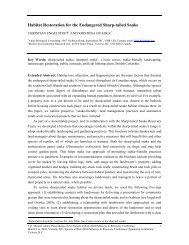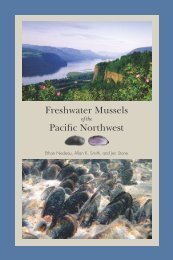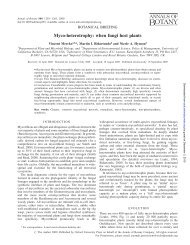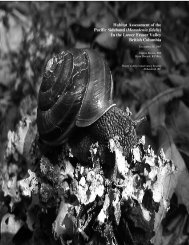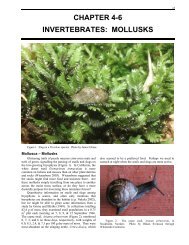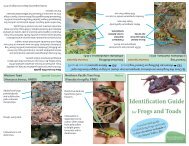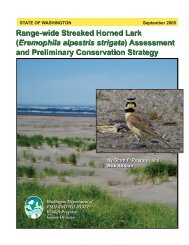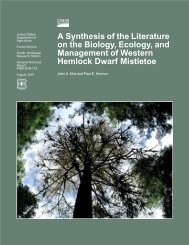28practices. Life-history pr<strong>of</strong>iling is likely where management effort would best be directedon co<strong>as</strong>tal cutthroat trout in the short-term, especially in the <strong>Lower</strong> Fr<strong>as</strong>er b<strong>as</strong>in wheregenetic fitness <strong>of</strong> various stocks could inadvertently be compromised by fish culturalpractices. Use <strong>of</strong> micro-chemical analyses <strong>of</strong> samples <strong>of</strong> scales, fin rays or otoliths andsupport by radio/sonic tracking should discern the ranges <strong>of</strong> migratory life histories thatare dominant among adult cutthroat from Fr<strong>as</strong>er b<strong>as</strong>in tributaries. Molecular geneticsampling is also apt to detect differences within the <strong>Lower</strong> Fr<strong>as</strong>er B<strong>as</strong>in, particularly ifcutthroat are sampled from large tributary b<strong>as</strong>ins including the Pitt, Harrison and LillooetRivers (R. Taylor pers. comm. 2005). In the interim, in advance <strong>of</strong> more detailed geneticanalysis work, stocks <strong>of</strong> different life histories and morphological features may be thebest indicators <strong>of</strong> genetic differences that control complex migratory behaviors. Toensure conservation, it should be <strong>as</strong>sumed that different pr<strong>of</strong>iles have a strong hereditaryb<strong>as</strong>is and should not be mixed in fish culture practices. Mixing discrete stocks may be <strong>of</strong>greater consequence than most contemporary hatchery practices, although unintentionalshifts in the modal timing <strong>of</strong> spawning (Chilcote et al. 1986) and family inbreeding arealso risks, particularly if hatchery fish are recycled.Another concern, directly related to fish culture, is hybridization <strong>of</strong> co<strong>as</strong>tal cutthroat troutwith steelhead/rainbow trout, which is readily detectable using molecular geneticsampling and analyses (Costello and Rubridge 2004). Reproductive isolation betweensteelhead/rainbow and co<strong>as</strong>tal cutthroat is maintained in the wild by habitat differences inpreferred stream selection <strong>as</strong> well <strong>as</strong> some temporal differences in spawning (Hartmanand Gill 1968). However, recent research indicates hybridization is much greater thanpreviously thought. Hybridization w<strong>as</strong> identified in 29 <strong>of</strong> 30 streams on VancouverIsland that supported sympatric populations <strong>of</strong> the two species, with hybridization ratesranging from 3 to 88 %, or 20 % on average (Bettles 2004). In two streams, Ch<strong>as</strong>e Riverand Cougar Creek, “hybrid swarms” appeared to occur, with introgression rates <strong>of</strong> up to54 %. Relatively high rates <strong>of</strong> hybridization have also been detected in the Keogh Riverwhere 10 % <strong>of</strong> the steelhead smolts were hybrids and 26 % <strong>of</strong> cutthroat parr/smolts werehybrids (D. McCubbing pers. comm. 2004).A suggested re<strong>as</strong>on for high rates <strong>of</strong> hybridization is “residualism” <strong>of</strong> hatchery steelheadand cutthroat, combined with poor survival <strong>of</strong> steelhead in the ocean. A significantincidence <strong>of</strong> non-migratory precocious males among stocked steelhead smolt groups mayincre<strong>as</strong>e the incidence <strong>of</strong> cross-mating. Many <strong>of</strong> these residual steelhead can be similarin size to maturing cutthroat, especially the resident form (Slaney and Harrower 1981).Rele<strong>as</strong>e <strong>of</strong> smolts near river mouths or tide-water reduces this risk, but these “residuals”have been documented to disperse upstream for two kilometers at the Keogh River(Slaney and Harrower 1981). In a parallel study <strong>of</strong> stocked cutthroat trout at LittleCampbell River, large hatchery steelhead (6000, 124 g) and cutthroat smolts (2000, 112g) were stocked three, five and seven km upstream <strong>of</strong> a counting fence. Only 57 % and42 %, respectively, migrated seaward and a high incidence <strong>of</strong> residualism w<strong>as</strong> detected.In two sampled stream sections (4 % <strong>of</strong> the stream length), residuals comprised 6 %(unstocked section) and 62 % (stocked section) <strong>of</strong> the total salmonid biom<strong>as</strong>s (such largeprecocious-prone smolts are no longer cultured and rele<strong>as</strong>ed in Region 2). This w<strong>as</strong>confirmed more recently by Bates (2000) by a comparison <strong>of</strong> life history characteristics
29<strong>of</strong> wild and hatchery juvenile cutthroat, each from wild brood sources. Although wildand hatchery juveniles grew at similar rates in the hatchery, hatchery fish grew moreslowly in the wild. Further, hatchery-reared fish matured earlier and exhibited a highfrequency (50%) <strong>of</strong> residual non-migrants. Thus, maturing “residuals” <strong>of</strong> a similar size<strong>of</strong> these two trout species in the same habitats are prone to spawn together and formhybrids. Further, a sharp decline in steelhead smolt-to-adult survival in the ocean overthe p<strong>as</strong>t decade h<strong>as</strong> resulted in much fewer steelhead spawners, which may be leading togreater potential for mixing with cutthroat spawners on spawning sites.Costello and Rubridge (2004) suggest that this high incidence <strong>of</strong> hybrids is indicative <strong>of</strong>an apparent lack <strong>of</strong> selection against them, which should otherwise occur. They furthersuggest it may be a combined result <strong>of</strong> habitat degradations and hatchery fishintroductions. They also submit that from an evolutionary genetics perspective, hybridswarms represent possible extinctions because although their genes are maintained, theyare not likely to be in the unique combinations <strong>of</strong> the original native populations. Thus,habitat protection and restoration along with minimizing steelhead stockings in cutthroathabitats, and visa versa, are management actions that would reduce genetic risks <strong>of</strong>hybridization.In summary, co<strong>as</strong>tal cutthroat trout demonstrate highly pl<strong>as</strong>tic life histories, which varyin dominance <strong>of</strong> a life history in any geographic region and perhaps even groups <strong>of</strong>streams (Northcote 1997). The general <strong>as</strong>sumption is that migratory behaviors aregenetically fixed, but they may be rather pl<strong>as</strong>tic, and only fixed within wide bounds.Thus, if environmental conditions change rapidly, adaptive behavior can be rapidlymobilized. Alternatively, it may only take a few generations to shift such behavior.Timing <strong>of</strong> spawning, for example, is highly heritable, yet it can be rapidly shifted in afew generations <strong>as</strong> it w<strong>as</strong> at Chambers Creek, W<strong>as</strong>hington. After a few generations peaktiming <strong>of</strong> spawning occurred in January instead <strong>of</strong> March-April, and such a timing wouldbe maladaptive in the wild. Accordingly, for management purposes related to fishculture, a conservative approach is to avoid mixing <strong>of</strong> discreet stocks and specieshydridization by: (1) <strong>as</strong>suming that cutthroat stocks are genetically different even ifcurrent molecular tools cannot distinguish among them; (2) minimizing residualismimpacts through selection <strong>of</strong> low risk stocking locations; and (3) minimizingopportunities for cultured cutthroat and steelhead to hybridize by adequately separatingstocking locations (although if a hatchery located within the watershed, the latter is achallenge).3. POPULATION DYNAMICS OF COASTAL CUTHROAT TROUT3.1 <strong>Cutthroat</strong> <strong>Trout</strong> Smolt YieldsResearch studies in the Pacific Northwest which document the population dynamics <strong>of</strong>co<strong>as</strong>tal cutthroat trout are sparse because most are directed at salmon and steelhead.Most information is from other studies where cutthroat trout were not a priority and thussmolt yields per unit <strong>of</strong> stream, age-specific survival rates, and stock-recruitmentrelationships are unavailable. <strong>Cutthroat</strong> smolt yields per unit stream length are not



